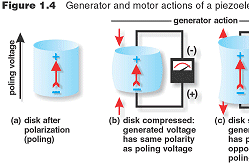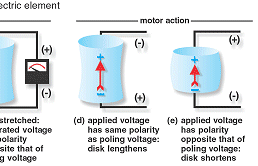

The direct piezoelectric effect is seen as a produced voltage when the material is under tension or compression stress. Each of these two types of stress generate opposite polarity voltages in the crystal. The inverted effect also occurs - this is when a potential difference is applied across the crystal and causes it to deform.
The deformation of the material brings the polarised dipoles closer into line, so that the positive and negative ends come closer together. As this happens the electric dipoles have a cumulative effect and a potential difference is set up over the whole crystal. The potential difference set up causes a positive charge at one end and a negative charge at the other end of the material.
The indirect or inverse piezoelectric occurs by exactly the opposite mechanism. A potential difference is placed across the material and at a great enough difference the electric field within the material will then create a large enough force on the dipoles to move them into alignment to lower the energy of the arrangement. The voltage needed to cause this effect is greater than the potential used for the initial poling process. This effect is also impermanent - there is an elastic relaxation to the original shape when the potential difference is removed, whereas a poled material remains poled even when the field is removed.


Image taken from American Piezo (without permission)